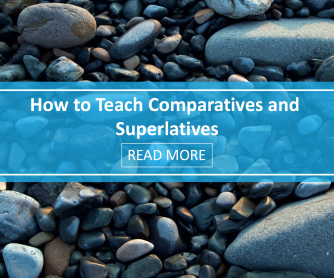“Comparisons are odious” says the old proverb, but in an ESL class they are also very necessary. And as there is not set rule for all adjectives, we must make sure students learn everything they need to know about comparatives and superlatives.
Comparatives and Superlatives Are Ready. Are You?
-
1
Introduce the comparative and superlative forms for one syllable adjectives
Show your students an illustration of people of different heights, or ask three students to stand up. Introduce the comparative of one syllable adjectives:
T: Juan is tall, but Mario is taller than Juan. Juan is shorter than Mario. Make sure students understand that for these adjectives the comparative is formed by adding -er. Students compare their heights.Point to the three students who are standing and introduce the superlative:
T: Mario is taller than Juan, but Sam is taller than Mario. Sam is the tallest of the three. Make sure students understand that the superlative is formed by adding –est. Students say who is the tallest and who is the shortest in the class. -
2
Introduce the comparative and superlative forms for one syllable adjectives ending in “e”
Show your students pictures of different types of furniture. Introduce the comparative:
T: This brown sofa is nice. But the red one is nicer than the brown one. It's also wider than the brown one. Make sure students understand that the comparative is formed by adding an r. Students compare the other pieces of furniture.Point to three different sofas and introduce the superlative:
T: The red sofa is nicer than the brown one, but the blue one is the nicest of the three. Make sure students understand that the superlative is formed by adding -st. Students say which pieces of furniture they think are the nicest, or the widest. -
3
Introduce the comparative and superlative forms for one syllable adjectives ending in consonant-vowel-consonant
Show your students picture or photos of different seasons and weather conditions. Introduce the comparative:
T: The weather in May can be hot, but the weather in June is hotter than in May. October is a wet month, but November is wetter than October. Make sure students understand that the comparative is formed by making the last consonant double and adding -er. Students compare the weather in different cities and countries with the aid of a weather chart. Encourage them to use other one syllable adjectives.Point to the weather charts and introduce the superlative:
T: November is the wettest month of the year. July is the hottest. Make sure students understand that the superlative is formed by making the last consonant double and adding -est. Students say which months are the hottest, the wettest, the coolest, the warmest, etc…in your city and others. -
4
Introduce the comparative and superlative forms for two syllable adjectives ending in “y”
Discuss feelings to introduce the comparative:
T: I am happy when I visit a friend, but I'm happier when it’s her birthday. Make sure students understand that the comparative is formed by replacing the “y” with an “i” and adding –er. Students compare their feelings in a variety of situations. Encourage them to use everything they’ve learned so far about comparisons.Introduce the superlative:
T: I am happy when I’m on vacation, but I’m the happiest when travel to a new place. Make sure students understand that the superlative is formed by replacing the “y” with an “i” and adding –est. Students say when they are the happiest, the sorriest, the saddest, etc… -
5
Introduce the comparative and superlative forms for two or more syllable adjectives
Show students pictures of popular vacation destinations and famous cities. Introduce the comparative:
T: Berlin is a beautiful city, but Paris is more beautiful than Berlin. Make sure students understand that the comparative is formed by using “more” plus the adjective. Students compare cities and countries trying to use long adjectives.Introduce the superlative:
T: Paris is a very beautiful city, but in my opinion Rome is the most beautiful city in the world. Make sure students understand that the superlative is formed by using “the most” plus the adjective. Students say which they believe are the most beautiful, the most expensive, and the most interesting cities in the world. -
6
Introduce the comparative and superlative forms of irregular adjectives
Continue with the comparison of cities and countries:
T: The traffic in London is bad, but the traffic in Rome is worse. The traffic in London is better than the traffic in Rome. Make sure students understand that “good” and “bad” are irregular adjectives and their comparatives are “better” and “worse”. Students make more comparisons.Introduce the superlative:
T: They say the traffic in Rome is the worst in the world. But it's the best place to visit in Italy. Make sure students understand that “the best” and “the worst” are the superlative forms of “good” and “bad”. Students say which they believe are the best sights to visit around the world, and which have the worst problems.
At BusyTeacher.org we have lots of worksheets for practicing Degrees of Comparison. Remember that if students are unsure about the comparative or superlative form of some adjectives, the best way to help them overcome this doubt is by offering lots and lots of practice.
P.S. If you enjoyed this article, please help spread it by clicking one of those sharing buttons below. And if you are interested in more, you should follow our Facebook page where we share more about creative, non-boring ways to teach English.








